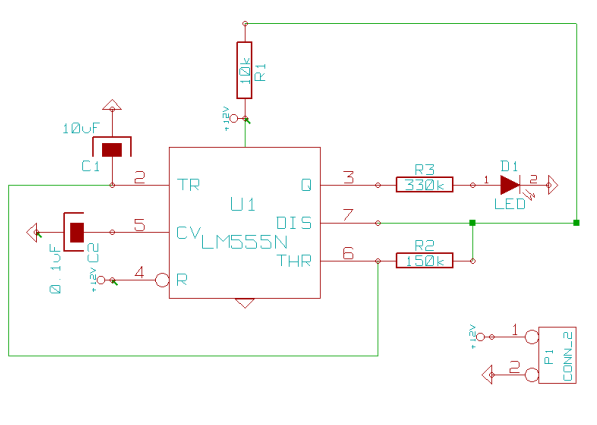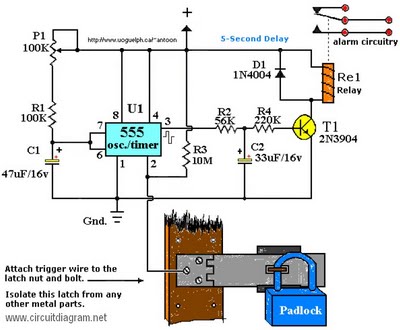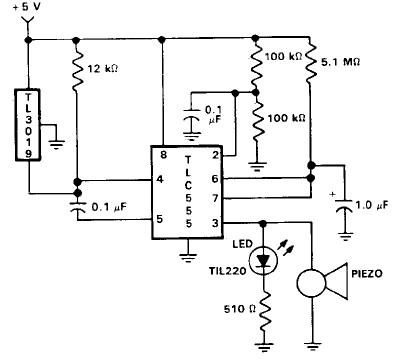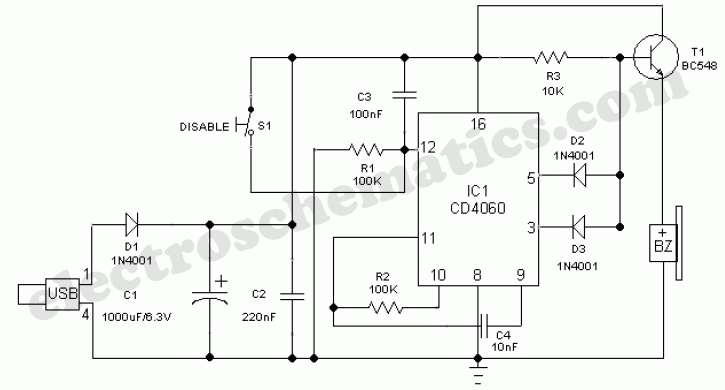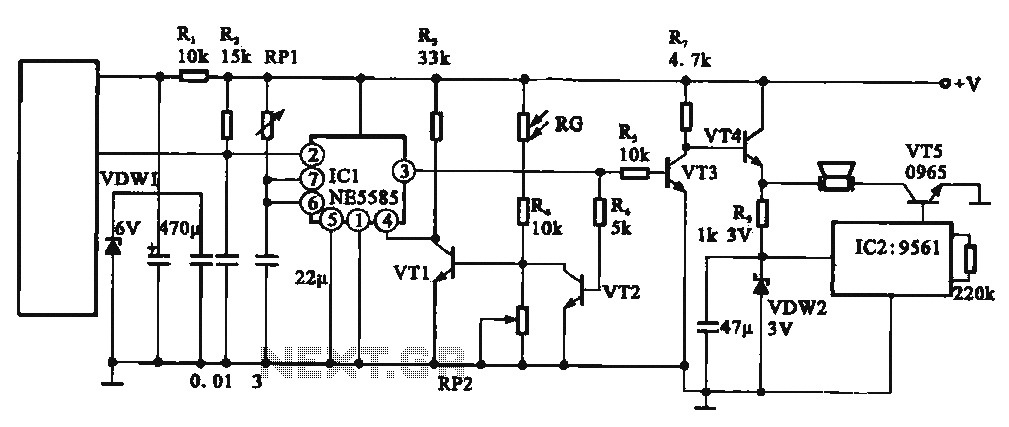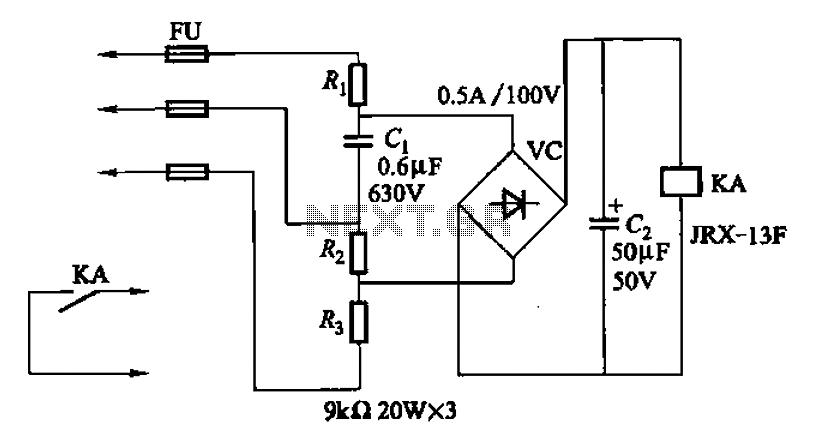
Modular Burglar Alarm
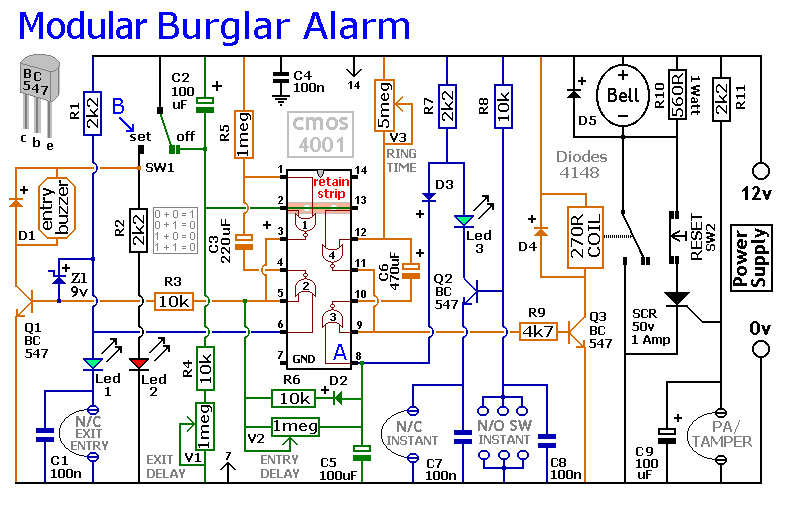
This circuit includes automatic exit and entry delays along with a timed bell cut-off. It accommodates both normally-closed and normally-open contacts and features a 24-hour personal attack/tamper zone. The circuit is permanently connected to a 12-volt supply, and its operation is activated by opening switch SW1. Expansion modules allow for the addition of multiple zones, which may include inertia (shock) sensor types. All green LEDs should illuminate before SW1 is opened, providing approximately one minute to exit the building. During this time, a buzzer will sound, ceasing when the door is closed, indicating the exit/entry loop has been restored within the allowed timeframe. Upon re-entering, there is again a one-minute window to turn SW1 off. Failure to do so will energize the relay and activate the main bell for up to 40 minutes, although it can be silenced at any time using SW1. The "Instant" zone is designed without an entry delay. If normally-open switches are not desired, components R8, C8, and Q2 can be omitted, and a link should be placed between LED 3 and C7. The 24-hour PA/tamper protection is facilitated by an SCR/thyristor; opening any switch in the normally-closed loop will trigger R11, activating the bell without a time limit. The bell can be reset by pressing SW2, temporarily interrupting the current flow. While the basic circuit is adequate for many applications, dividing the alarm into zones simplifies fault detection, with the control panel capable of identifying the zone that caused activation. Expansion modules are designed to enhance this functionality, potentially replacing the existing instant zone. When a zone is triggered, its corresponding red LED will illuminate and remain lit until the reset button is pressed. All modules can utilize a single reset button.
This circuit design is structured to enhance security through its automatic exit and entry features, combined with a robust tamper protection system. The integration of both normally-closed and normally-open contacts allows for flexibility in installation, catering to various sensor types and user preferences. The 12-volt supply connection ensures consistent power, enabling reliable operation of all components.
The timed exit and entry delays are critical for users, providing a grace period during which they can safely exit or enter the premises without triggering an alarm. The buzzer serves as an audible alert, reinforcing the need to complete the exit or entry process within the designated timeframe. The functionality of the main bell, which can be silenced at any moment, adds an additional layer of user control, ensuring that false alarms can be managed effectively.
The 24-hour personal attack/tamper zone, supported by the SCR/thyristor, is particularly significant in high-security environments. The immediate response to any tampering attempts ensures that security is maintained at all times, with the capability to reset the system quickly through SW2. This feature is essential for maintaining operational integrity after a security event.
The expansion modules are a vital aspect of this circuit, as they provide scalability to the system. Users can customize their security setup according to their specific needs, adding zones as required. The ability to identify which zone has been activated enhances troubleshooting and response efforts, making it easier to address potential security breaches.
Overall, this circuit is designed for versatility and reliability, making it suitable for a wide range of applications in security systems. The clear indication of alarm status through LEDs and the shared reset functionality across modules contribute to an intuitive user experience, ensuring that the system remains effective in protecting the premises.This circuit features automatic Exit and Entry delays and a timed Bell Cut-off. It has provision for both normally-closed and normally-open contacts, and a 24-hour Personal Attack/Tamper zone. It is connected permanently to the 12-volt supply and its operation is "enabled" by opening SW1. By using the expansion modules, you can add as many zones a s you require; some or all of which may be the inertia (shock) sensor type. All the green LEDs should be lighting before you open SW1. You then have up to about a minute to leave the building. As you do so, the Buzzer will sound. It should stop sounding when you shut the door behind you. This indicates that the Exit/Entry loop has been successfully restored within the time allowed. When you re-enter the building you have up to about a minute to move SW1 to the off position. If SW1 is not switched off in time, the relay will energise and sound the main bell. It will ring for up to about 40 minutes. But it can be turned off at any time by SW1. The "Instant" zone has no Entry Delay. If you don`t want to use N/O switches, leave out R8, C8 and Q2; and fit a link between Led 3 and C7. The 24 Hour PA/Tamper protection is provided by the SCR/Thyristor. If any of the switches in the N/C loop is opened, R11 will trigger the SCR and the bell will ring. In this case the bell has no time limit. Once the loop is closed again, the SCR may be reset by pressing SW2 and temporarily interrupting the current flow. The basic circuit will be satisfactory in many situations. However, it`s much easier to find a fault when the alarm is divided into zones and the control panel can remember which zone has caused the activation.
The expansion modules are designed to do this. Although they will work with the existing instant zone, they are intended to replace it. When a zone is activated, its red LED will light and remain lit until the reset button is pressed. All the modules can share a single reset button. 🔗 External reference
This circuit design is structured to enhance security through its automatic exit and entry features, combined with a robust tamper protection system. The integration of both normally-closed and normally-open contacts allows for flexibility in installation, catering to various sensor types and user preferences. The 12-volt supply connection ensures consistent power, enabling reliable operation of all components.
The timed exit and entry delays are critical for users, providing a grace period during which they can safely exit or enter the premises without triggering an alarm. The buzzer serves as an audible alert, reinforcing the need to complete the exit or entry process within the designated timeframe. The functionality of the main bell, which can be silenced at any moment, adds an additional layer of user control, ensuring that false alarms can be managed effectively.
The 24-hour personal attack/tamper zone, supported by the SCR/thyristor, is particularly significant in high-security environments. The immediate response to any tampering attempts ensures that security is maintained at all times, with the capability to reset the system quickly through SW2. This feature is essential for maintaining operational integrity after a security event.
The expansion modules are a vital aspect of this circuit, as they provide scalability to the system. Users can customize their security setup according to their specific needs, adding zones as required. The ability to identify which zone has been activated enhances troubleshooting and response efforts, making it easier to address potential security breaches.
Overall, this circuit is designed for versatility and reliability, making it suitable for a wide range of applications in security systems. The clear indication of alarm status through LEDs and the shared reset functionality across modules contribute to an intuitive user experience, ensuring that the system remains effective in protecting the premises.This circuit features automatic Exit and Entry delays and a timed Bell Cut-off. It has provision for both normally-closed and normally-open contacts, and a 24-hour Personal Attack/Tamper zone. It is connected permanently to the 12-volt supply and its operation is "enabled" by opening SW1. By using the expansion modules, you can add as many zones a s you require; some or all of which may be the inertia (shock) sensor type. All the green LEDs should be lighting before you open SW1. You then have up to about a minute to leave the building. As you do so, the Buzzer will sound. It should stop sounding when you shut the door behind you. This indicates that the Exit/Entry loop has been successfully restored within the time allowed. When you re-enter the building you have up to about a minute to move SW1 to the off position. If SW1 is not switched off in time, the relay will energise and sound the main bell. It will ring for up to about 40 minutes. But it can be turned off at any time by SW1. The "Instant" zone has no Entry Delay. If you don`t want to use N/O switches, leave out R8, C8 and Q2; and fit a link between Led 3 and C7. The 24 Hour PA/Tamper protection is provided by the SCR/Thyristor. If any of the switches in the N/C loop is opened, R11 will trigger the SCR and the bell will ring. In this case the bell has no time limit. Once the loop is closed again, the SCR may be reset by pressing SW2 and temporarily interrupting the current flow. The basic circuit will be satisfactory in many situations. However, it`s much easier to find a fault when the alarm is divided into zones and the control panel can remember which zone has caused the activation.
The expansion modules are designed to do this. Although they will work with the existing instant zone, they are intended to replace it. When a zone is activated, its red LED will light and remain lit until the reset button is pressed. All the modules can share a single reset button. 🔗 External reference
